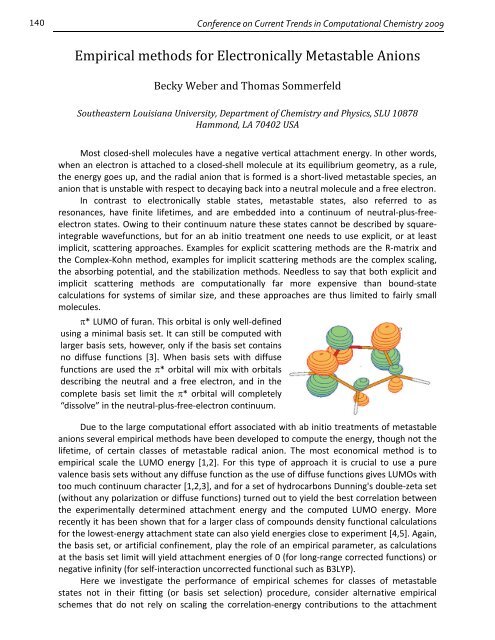Proceedings - Interdisciplinary Center for Nanotoxicity
Proceedings - Interdisciplinary Center for Nanotoxicity
Proceedings - Interdisciplinary Center for Nanotoxicity
Create successful ePaper yourself
Turn your PDF publications into a flip-book with our unique Google optimized e-Paper software.
140<br />
Conference on Current Trends in Computational Chemistry 2009<br />
Empirical methods <strong>for</strong> Electronically Metastable Anions<br />
Becky Weber and Thomas Sommerfeld<br />
Southeastern Louisiana University, Department of Chemistry and Physics, SLU 10878<br />
Hammond, LA 70402 USA<br />
Most closed‐shell molecules have a negative vertical attachment energy. In other words,<br />
when an electron is attached to a closed‐shell molecule at its equilibrium geometry, as a rule,<br />
the energy goes up, and the radial anion that is <strong>for</strong>med is a short‐lived metastable species, an<br />
anion that is unstable with respect to decaying back into a neutral molecule and a free electron.<br />
In contrast to electronically stable states, metastable states, also referred to as<br />
resonances, have finite lifetimes, and are embedded into a continuum of neutral‐plus‐free‐<br />
electron states. Owing to their continuum nature these states cannot be described by square‐<br />
integrable wavefunctions, but <strong>for</strong> an ab initio treatment one needs to use explicit, or at least<br />
implicit, scattering approaches. Examples <strong>for</strong> explicit scattering methods are the R‐matrix and<br />
the Complex‐Kohn method, examples <strong>for</strong> implicit scattering methods are the complex scaling,<br />
the absorbing potential, and the stabilization methods. Needless to say that both explicit and<br />
implicit scattering methods are computationally far more expensive than bound‐state<br />
calculations <strong>for</strong> systems of similar size, and these approaches are thus limited to fairly small<br />
molecules.<br />
π* LUMO of furan. This orbital is only well‐defined<br />
using a minimal basis set. It can still be computed with<br />
larger basis sets, however, only if the basis set contains<br />
no diffuse functions [3]. When basis sets with diffuse<br />
functions are used the π* orbital will mix with orbitals<br />
describing the neutral and a free electron, and in the<br />
complete basis set limit the π* orbital will completely<br />
“dissolve” in the neutral‐plus‐free‐electron continuum.<br />
Due to the large computational ef<strong>for</strong>t associated with ab initio treatments of metastable<br />
anions several empirical methods have been developed to compute the energy, though not the<br />
lifetime, of certain classes of metastable radical anion. The most economical method is to<br />
empirical scale the LUMO energy [1,2]. For this type of approach it is crucial to use a pure<br />
valence basis sets without any diffuse function as the use of diffuse functions gives LUMOs with<br />
too much continuum character [1,2,3], and <strong>for</strong> a set of hydrocarbons Dunning's double‐zeta set<br />
(without any polarization or diffuse functions) turned out to yield the best correlation between<br />
the experimentally determined attachment energy and the computed LUMO energy. More<br />
recently it has been shown that <strong>for</strong> a larger class of compounds density functional calculations<br />
<strong>for</strong> the lowest‐energy attachment state can also yield energies close to experiment [4,5]. Again,<br />
the basis set, or artificial confinement, play the role of an empirical parameter, as calculations<br />
at the basis set limit will yield attachment energies of 0 (<strong>for</strong> long‐range corrected functions) or<br />
negative infinity (<strong>for</strong> self‐interaction uncorrected functional such as B3LYP).<br />
Here we investigate the per<strong>for</strong>mance of empirical schemes <strong>for</strong> classes of metastable<br />
states not in their fitting (or basis set selection) procedure, consider alternative empirical<br />
schemes that do not rely on scaling the correlation‐energy contributions to the attachment



